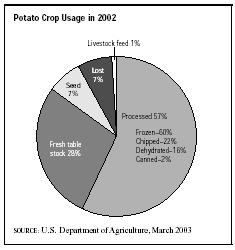SIC 0134
IRISH POTATOES
This industry classification includes establishments primarily engaged in the production of potatoes, except sweet potatoes, which are part of SIC 0139: Field Crops Except Cash Grains, Not Elsewhere Classified.
NAICS Code(s)
111211 (Potato Farming)
The potato, a member of the nightshade family that produces thick, fleshy tubers from underground stems, was introduced into the United States around 1719, but it was not mentioned in crop production data until the 1840 census, which listed 160.4 million pounds of potatoes grown. American per capita potato consumption peaked in the early twentieth century at 198 pounds, dropped to about 103 pounds by 1956, and rose again to its 2002 level of 140 pounds per person as people consumed more processed potatoes. Of the total U.S. potato crop in 2002, 28 percent was distributed fresh to consumers, while 69 percent was processed, either frozen as chips or shoestrings, dehydrated, or canned. In addition, a portion of each year's 438 million hundredweight crop (hundredweight is a unit of measure equaling 100 pounds, abbreviated cwt.) is used for seed and for feeding livestock. Although there are more than 80 varieties of potatoes planted in the United States, six varieties dominate production: Russet Burbank, Russet Norkotah, Atlantic, Ranger Russet, Frito-Lay, and Shepody.
American potato farmers plant relatively few acres, just 1.3 million in 2002, yet the high yield of Irish potatoes allows them to supply domestic potato production of almost 500 million cwt. of potatoes per year, according to U.S. Department of Agriculture (USDA) statistics. In fact, the Irish potato yields more food per unit area of land planted than any other major crop. Potatoes are grown commercially in 35 American states, from Alaska to Maine to Florida, but more than 50 percent of the 2002 potato crop was produced by just three states: Idaho, Oregon, and Washington. Western states account for 65 percent of total U.S. potato production, while Central states produce another 25 percent, and Eastern states make up the remaining 10 percent. Altogether, U.S. growers tend to produce about seven percent of the world's potatoes.
Mechanization revitalized potato farming by reducing the amount of manual labor involved. Seed potatoes

(precut sections of potato) are planted using an automatic planter pulled behind a tractor. Such planters can plant four or more rows at a time and require only a tractor driver and a tender. Potatoes are harvested mechanically as well, with machines that dig out the entire potato plant, shake free excess dirt and rocks, and deposit the potatoes in an adjacent truck. In the southern United States, potato farmers are able to reap four harvests per year, while in the northwestern states, where most of the U.S. crop is grown, potatoes are harvested primarily in the fall. After they are harvested, potatoes are placed in cool (45-60 degrees Fahrenheit), humid storage areas to allow for healing of surface damage, a process called curing. Because potatoes are distributed throughout the year, roughly 63 percent of each year's potato crop is placed in storage, where the potatoes are maintained in carefully controlled conditions to prevent rot, dehydration, and a wide range of diseases.
In recent years researchers have attempted to counter various diseases that can affect potato crops. One promising experiment undertaken by Purdue University researchers was to take a gene from tobacco plants and insert it into potato plants. "This gene codes for a protein, called osmotin, that brings death to the fungi by chemically drilling holes in their cell membranes," noted Business Week in 1994. "For humans, the protein is probably safe … since it's produced by many food plants." Testing continues on the potato, as well as other crops such as soybeans, corn, and tomatoes.
The potato crop's value hovered between $2 and $3 billion in the early 2000s. Major potato producers include Sunny Farms and Anthony Farms, Inc., which averaged about $8 million and $7 million in sales from potatoes per year, respectively. The 2002 growing season brought U.S. farmers a crop of 438 million cwt. from some 1.3 million acres. A slight decrease in domestic french fry consumption growth was offset in the early 2000s due to increased exports. U.S. potato farmers exported more than 1 billion pounds of frozen french fries, more than half of which went to Japan.
In recent years, as research reveals more about the potato both as a source of nutrition and vitamins and its chemistry—how it is metabolized and synthesized by the human body—scientists and researchers are coming to some interesting conclusions. Studies indicate that potatoes rank with other glycemic foods: potatoes raise a person's blood sugar as much as sugar does. Because the starches in white bread and potatoes are quickly metabolized as sugars by the body, diabetics are potentially at risk; some nutritionists and scientists recommend that the potato be reclassified as a complex carbohydrate, along with rice and pasta, rather then as a vegetable. In 2002, potatoes accounted for 15 percent of U.S. vegetable cash receipts.
Further Reading
American Institute for Cancer Research, Special Research Report, 22 January 2000. Available from http://airweb@aircr.org .
Collins, Karen, R.D., "Potatoes: Friend or Foe?" Nutrition Notes, MSNBC, 22 January 2000. Available from http://MSNBC.com/Healthpage/NutritionNotes/ .
Port, Otis. "Bioengineering Comes to the Potato Patch." Business Week, 16 May 1994.
"Potato Growers Push for Another Cut in Acreage." Successful Farming, February 2002.
U.S. Department of Agriculture. Economic Research Service. "Potatoes." Washington, D.C., 2003. Available from http://www.ers.usda.gov/briefing/potatoes/trade.htm .
Comment about this article, ask questions, or add new information about this topic: